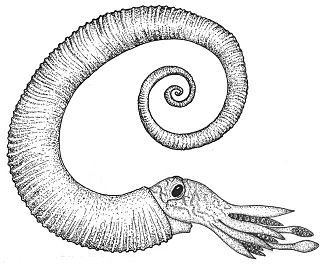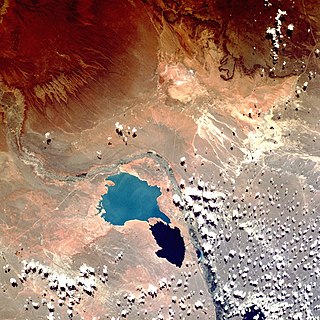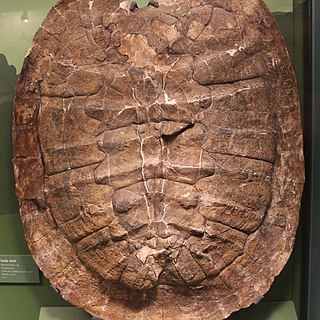The Cretaceous is a geological period that lasted from about 145 to 66 million years ago (Mya). It is the third and final period of the Mesozoic Era, as well as the longest. At around 79 million years, it is the longest geological period of the entire Phanerozoic. The name is derived from the Latin creta, "chalk", which is abundant in the latter half of the period. It is usually abbreviated K, for its German translation Kreide.

The Chalk Group is the lithostratigraphic unit which contains the Upper Cretaceous limestone succession in southern and eastern England. The same or similar rock sequences occur across the wider northwest European chalk 'province'. It is characterised by thick deposits of chalk, a soft porous white limestone, deposited in a marine environment.

The Ancyloceratina were a diverse suborder of ammonite most closely related to the ammonites of order Lytoceratina. They evolved during the Late Jurassic but were not very common until the Cretaceous period, when they rapidly diversified and became one of the most distinctive components of Cretaceous marine faunas. They have been recorded from every continent and many are used as zonal or index fossils. The most distinctive feature of the majority of the Ancyloceratina is the tendency for most of them to have shells that are not regular spirals like most other ammonites. These irregularly-coiled ammonites are called heteromorph ammonites, in contrast to regularly coiled ammonites, which are called homomorph ammonites.
The Coniacian is an age or stage in the geologic timescale. It is a subdivision of the Late Cretaceous Epoch or Upper Cretaceous Series and spans the time between 89.8 ± 1 Ma and 86.3 ± 0.7 Ma. The Coniacian is preceded by the Turonian and followed by the Santonian.

Mochlodon is a genus of rhabdodontid dinosaurs from the Late Cretaceous of Austria and Hungary. It lived during the Late Cretaceous and two species are known: M. suessi and M. vorosi.

The Neuquén Group is a group of geologic formations found in Argentina. Rocks in the Neuquén Group fall within the Cenomanian to early Campanian stages of the Late Cretaceous Period. It overlies the older Lohan Cura Formation and is itself overlain by the younger Allen Formation of the Malargüe Group, separated from both by unconformities, dated to 98 and 79 Ma respectively.

Inoceramus is an extinct genus of fossil marine pteriomorphian bivalves that superficially resembled the related winged pearly oysters of the extant genus Pteria. They lived from the Early Jurassic to latest Cretaceous.

Allocrioceras is an ammonoid cephalopod from the Turonian to Santonian stages of the Late Cretaceous, included in the turrilitoid family Anisoceratidae. Its shell is strongly ribbed and is in the form of a widely open spiral.

Peirosauridae is a Gondwanan family of mesoeucrocodylians that lived during the Cretaceous period. It was a clade of terrestrial crocodyliforms that evolved a rather dog-like form, and were terrestrial carnivores. It was phylogenetically defined in 2004 as the most recent common ancestor of Peirosaurus and Lomasuchinae and all of its descendants. Lomasuchinae is a subfamily of peirosaurids that includes the genus Lomasuchus.
The Matanuska Formation consists of more than 3 km (1.9 mi) of sedimentary strata exposed in the northern Chugach Mountains, Matanuska Valley, and southern Talkeetna Mountains of South-Central Alaska. The Matanuska Formation contains strata from Early Cretaceous (Albian) to Late Cretaceous (Maestrichtian). Parts of the formation contain abundant marine mollusks, foraminifera, and radiolaria. Fossils of non-marine plants are found in some beds. Fossils of two dinosaurs have been recovered from marine mudstones in the formation. The lower Matanuska Formation (MF) is several hundred meters thick and includes non-marine and marine sediments. Campanian-Maastrichtian graded sandstone, conglomerate, and mudstone comprise the upper 2000 meters of the Formation.

The Gosau Group is a geological stratigraphic group in Austria, Germany and western Slovakia whose strata date back to the Late Cretaceous to Eocene. It is exposed in numerous sporadic isolated basins within the Northern Calcareous Alps. It is divided into two subgroups, the Lower Gosau Subgroup which dates from the Turonian to Campanian, approximately 90 to 75 Ma and the Upper Gosau Subgroup which dates to the Santonian to Eocene, about 83.5 to 50 Ma. The formations within each subunit vary significantly between basins. The sequence is largely marine, but the Grünbach Formation represents a terrestrial deposit. Many of the units of the group are fossiliferous, typically providing marine fossils such as ammonites, though terrestrial remains including those of dinosaurs are known from the Grünbach Formation and Schönleiten Formation.

Ovaloolithus is an oogenus of dinosaur egg. Eggs of the genus have been found in China, Mongolia and Utah.

Eubostrychoceras is a genus of helically wound, corkscrew form, heteromorph ammonite which lived during the Upper Cretaceous. The genus is included in the ancycleratid family Nostoceratidae.

Pachydesmoceras is a genus of ammonites belonging to the family Desmoceratidae.

Paleontology in Alaska refers to paleontological research occurring within or conducted by people from the U.S. state of Alaska. During the Late Precambrian, Alaska was covered by a shallow sea that was home to stromatolite-forming bacteria. Alaska remained submerged into the Paleozoic era and the sea came to be home to creatures including ammonites, brachiopods, and reef-forming corals. An island chain formed in the eastern part of the state. Alaska remained covered in seawater during the Triassic and Jurassic. Local wildlife included ammonites, belemnites, bony fish and ichthyosaurs. Alaska was a more terrestrial environment during the Cretaceous, with a rich flora and dinosaur fauna.

Macrobaenidae is an extinct family of turtles, known from the Early Cretaceous to Paleogene of Laurasia. Their relationships to other turtles and whether or not they form a monophlyletic group are controversial. They are typically interpreted as stem or crown group cryptodires, but some more recent analyses have found them to lie outside crown group Testudines. Macrobaenids can be distinguished from other testudinatans by the presence of a carotid fenestra, cruciform plastron with strap-like epiplastra, and a lack of extragulars.

The Conejo Formation (Spanish: Formación Conejo, K2C, Kscn) is a fossiliferous geological formation of the Altiplano Cundiboyacense, Eastern Ranges of the Colombian Andes. The uppermost unit of the Villeta Group, a sequence of shales and sandstones dates to the Late Cretaceous period; Turonian, Coniacian and Santonian epochs, and has a maximum thickness of 1,022 metres (3,353 ft).

Naomichelys is an extinct genus of helochelydrid stem turtle known from the Cretaceous (Aptian-Campanian) of North America. It is the only member of the family known to be native to North America.
The Schönleiten Formation is a geological formation in Austria. Part of the Gosau Group it was deposited during the later Turonian of the Cretaceous period. It primarily consists of grey, weathered yellow shales and dense sandstone, with coal bearing shales near the base. The remains of indeterminate frogs, snakes, Tethysaurines, crocodylians and the teeth of cf. Paronychodon and other indeterminate theropod dinosaurs are known from the formation.

Cremnoceramus is an extinct genus of fossil marine pteriomorphian bivalves that superficially resembled the related winged pearly oysters of the extant genus Pteria. They lived from the Turonian to the Maastrichtian of the Late Cretaceous.
















